
Plant These for the Bumblebees
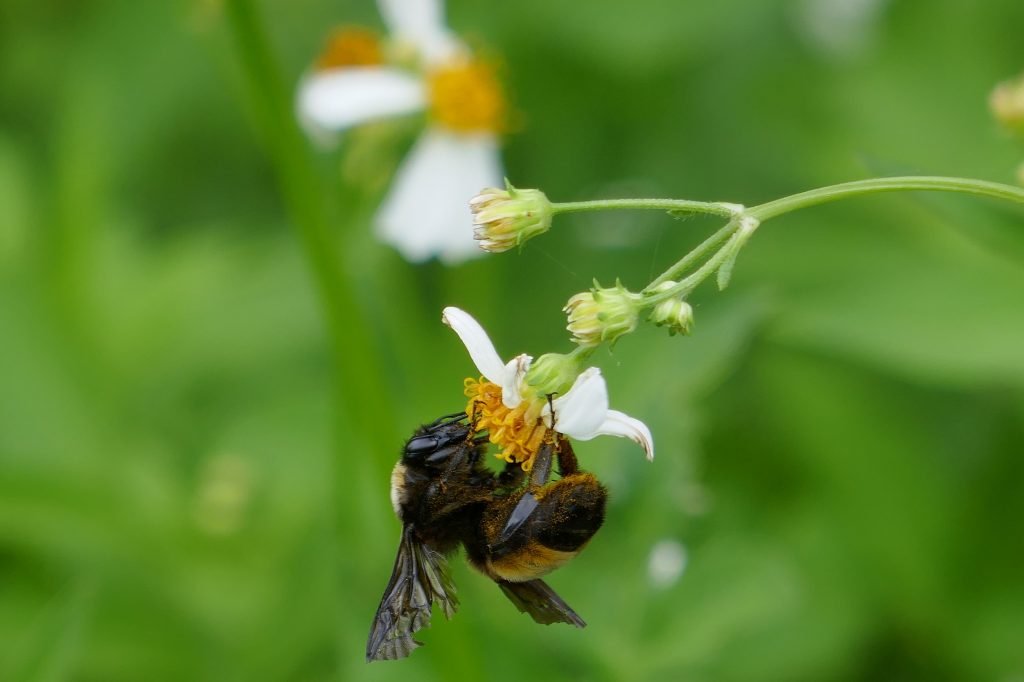
All pollinators, not just the bees, benefit when we plant flowers, and banish the use of poisons, and pesticides. However, the wildflowers’ I have listed in this article produce larger flowers which, in turn, attract larger pollinators – especially big bees. Florida’s large bees consist of bumblebees, carpenter bees, and mason bees.
A ‘big bee’ may look imposing, but it happily shares our garden and green space with us without harming, or even threatening, us in any way. They go about their daily lives in the garden relatively quietly and without any drama, and, in my opinion, make for rather good company. And besides, without them our flowers would not get pollinated, and without that, there can be no seeds, fruit, vegetables, and so forth.
Of course bees will sting, but only as a defensive mechanism when dealing with threats of harm to self, home or family … basically, like humans … so give them a break. They can sting if accidentally handled roughly, say when a gardener grabs a handful of flowers which contain a bee, or if we inadvertently step on or lean against one. The bee is merely trying to protect itself and so will sting out of pure survival instinct.
The other situation in which bees will sting is during home-defense. Damaging or stirring up a hive or nest is universally understood as an invitation to a sting. Bees in a colony will even coordinate an attack and have been known to chase away a threat for some distance. A threat to their hive is often literally a life or death situation for them. Most big bees, however, with the exception of the bumblebee, are solitary bees and thus do not form colonies or exhibit this behavior. The bumblebee colony is generally easily spotted and so can be avoided.
Allow your bees to go about their daily routines and do their work and in return, you help them fulfill a crucial role in the life and renewal of your plants. This simple relationship, one requiring nothing more from us than understanding and tolerance, yields rewards that are dramatically skewed in our favor. The next time you bite into a beautiful, ripe tomato you harvested that same day from your garden, remember the bee that tended the flower to make it a reality.
Viva la big bee!
Florida Wildflowers That Attract Bumblebees
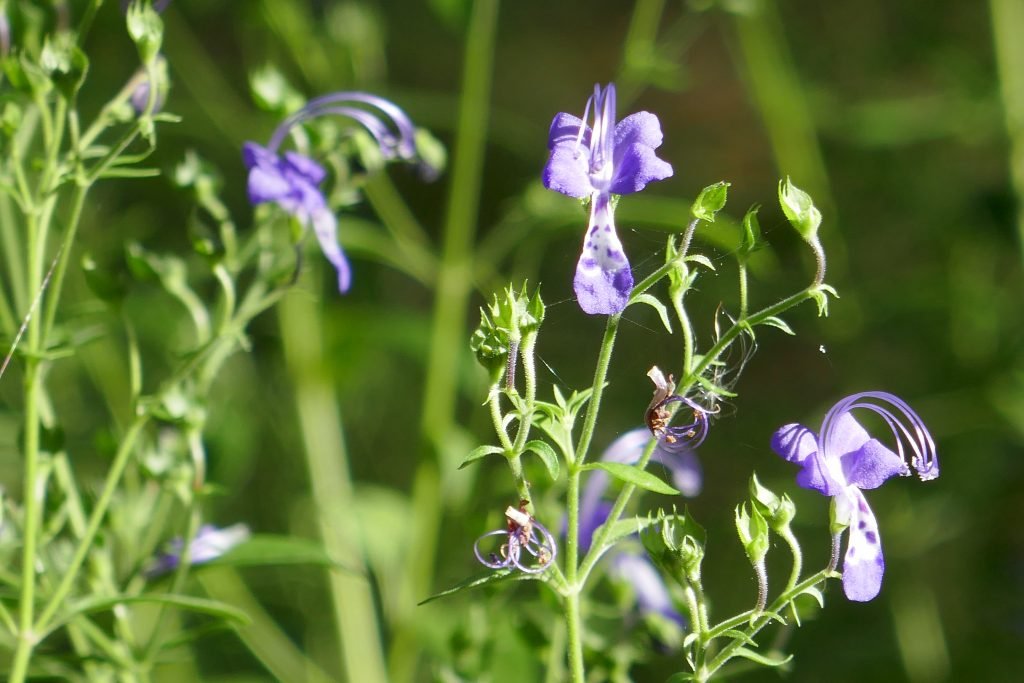
Blue Curls
(Trichostema dichotomum)
Common Name: Blue Curls
Latin Name: Trichostema dichotomum
Family: Lamiaceae (Mint Family)
Form: A perennial wildflower that grows to a height of 3 feet tall.
Range: It is native to the southeastern United States and can be found from Florida north into Canada. It is found throughout the state.
Leaves: Opposite, elliptic to lanceolate, with some margins having teeth and some not.
Flowers: The deep blue flowers appear in the summer and fall.
Habitat: Its natural distribution in Florida is dry pinelands, open woods, and thickets.
Landscape use: In the home landscape it grows in part shade with average to dry soils. Some literature lists it as an annual. However, in frost free areas it grows as a perennial.
Wildlife use: Bees and other small pollinators use the flowers for a source of nectar and pollen.
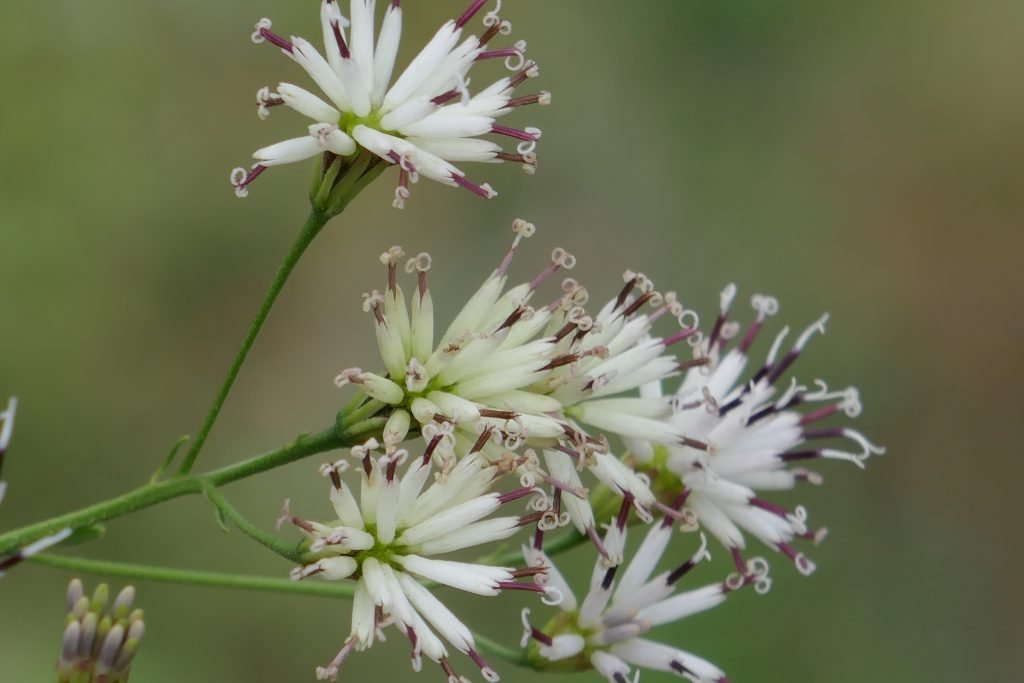
Feay's Palafox
(Palafoxia feayi)
Common Name: Feay’s Palafox
Latin Name: Palafoxia feayi
Family: Asteraceae (Aster Family)
Form: A perennial wildflower that reaches a height of 3-4 feet. The lower stems become woody and the plants take on a thin shrub like appearance.
Leaves: Alternate, with entire margins and ovate to lanceolate in shape.
Flowers: The flowers appear on the plant in branching corymbs. The florets are tubular and white to pale purple in color with dark anthers that extend past the tubes. Flowers appear in the summer and fall.
Habitat: Pinelands, scrub, and dry, sandy thickets.
Native range: Endemic to Central and south Florida
Landscape use: In the home landscape it can be grown in high shifting shade with average to dry soil moisture.
Wildlife use: The flowers are an important nectar source for bees and butterflies.
Propagation: The seeds require 90 days cold stratification in order to break dormancy.

Florida Betony
(Stachys floridana)
Common Name: Florida betony
Latin Name: Stachys floridana
Family: Lamiaceae (Mint Family)
Form: A perennial wildflower that grows to a height of 1 1/2 feet tall.
Range: Central and south Florida
Leaves: The leaves appear opposite are lanceolate in shape with shorts stalks and toothed margins.
Flowers: The pink flowers appear in the summer and fall.
Habitat: Its natural distribution in Florida is pine flatwoods, disturbed sites, roadsides, and open woods.
Landscape use: In the home landscape it grows in part shade with average moisture.
Wildlife use: Bees and other small pollinators use the flowers for a source of nectar.
Propagation: This wildflower spreads by runners and tubers which are easy to transplant. It can also be grown from seeds.
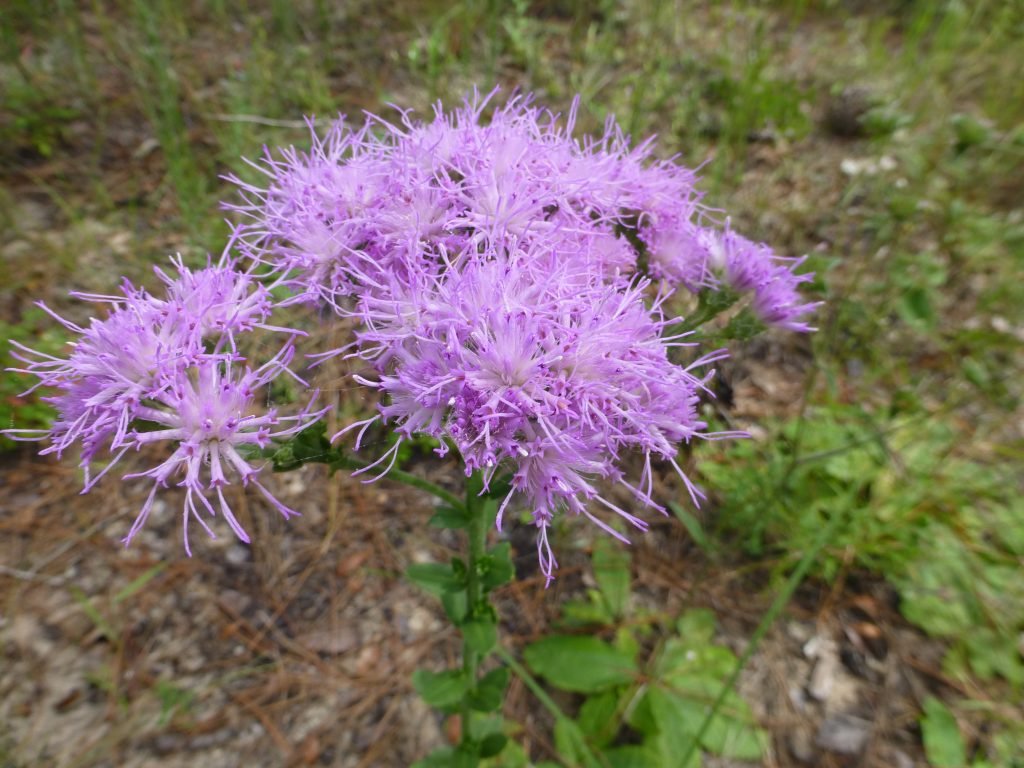
Florida Paintbrush
(Carphephorus corymbosus)
Common Name: Florida paintbrush
Latin Name: Carphephorus corymbosus
Family: Asteraceae (Aster Family)
Form: A perennial wildflower that grows to a height of three feet when in bloom.
Leaves: When not in bloom the leaves form a basal rosette of spatulate leaves. The upper leaves of the main stalks are alternate, and elliptic in shape.
Flowers: Purple flowers appear in late summer and early fall with some occasionally blooming into early winter.
Habitat: Pinelands and dry habitats.
Native range: It is native to Florida, Georgia and South Carolina.
Landscape use: It grows in full sun to part shade with average to dry soils.
Wildlife use: Florida paintbrush is a favorite nectar plant for butterflies and bees!
Propagation: Can be grown from seed, but the seeds need 90 days cold stratification. It transplants very well, but be sure to remove the flower head while doing so.

Heart-leaf Skullcap
(Scutellaria ovata subsp. bracteata)
Common Name: Heartleaf Skullcap
Latin Name: Scutellaria ovata subsp. bracteata
Family: Lamiaceae (Mint Family)
Form: It is a perennial wildflower that grows to a height of about 10-12 inches when in bloom.
Leaves: The leaves are opposite, stalked, ovate in shape with crenate margins.
Flowers: The lavender colored flowers appear in the spring and continue until early summer. Once the summer heat sets in the plant begins to go dormant.
Habitat: It grows in just about any soil from rocky limestone outcrops to rich loam underneath oak trees.
Native range: This is an uncommon wildflower for Florida and has only been documented growing in the wild in two counties. It is native to AL, AR, FL, GA, IL, KS, KY, LA, MO, MS, OK, TX.
Landscape use: It grows in part shade, to almost complete shade, but produces more flowers the more sunlight it gets. Plant growth appears in late winter and flowering begins soon afterwards. Once established it will spread by tubers and reseed in the general area.
Wildlife use: It is a much sought after nectar source for bees in late winter when few flowers are blooming.
Propagation: The plant can be propagated through seeds and transplanting tubers.
I’m proud to say that my friend Don Robinson found this plant while we were conducting a field trip at a rock mine in Brooksville, and with the help of Annie Schmidt, he and I submitted it to the Atlas of Florida Plants at the herbarium at the University of South Florida and became the first to document it for Hernando County.
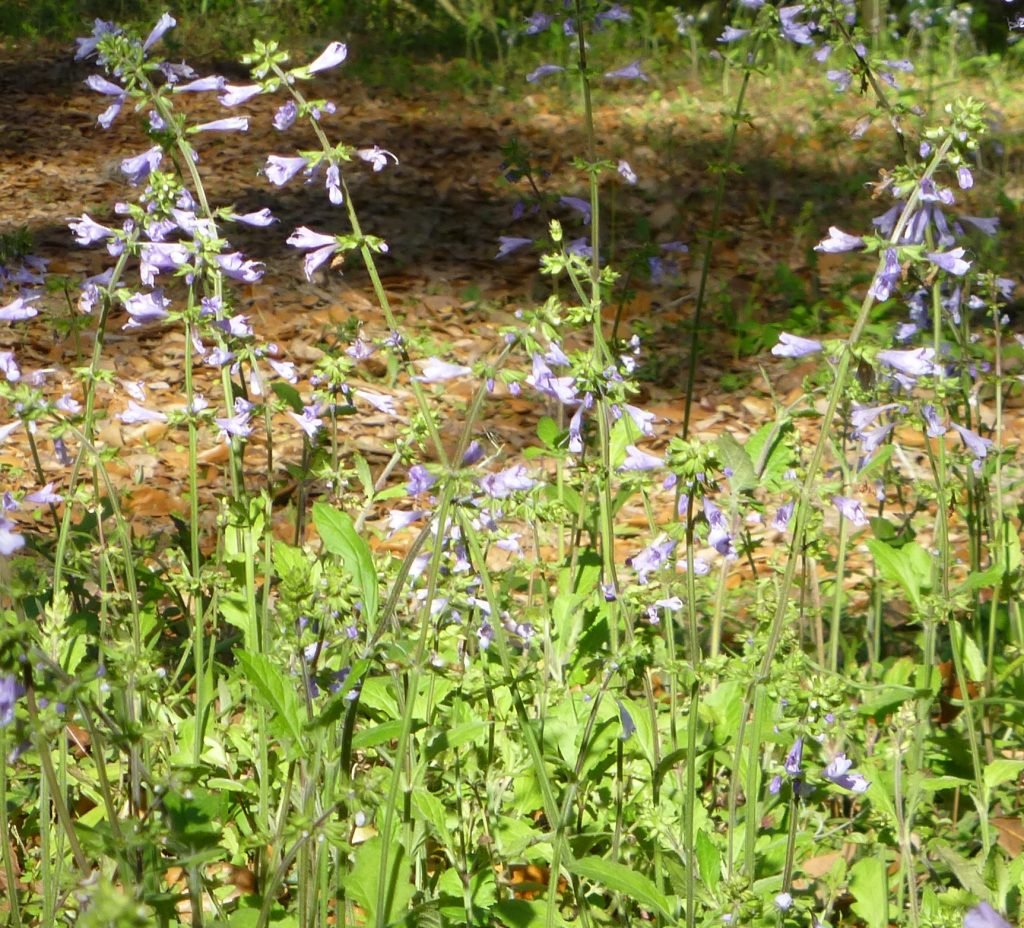
Lyre-leaf Sage
( Salvia lyrata)
Common Names: Lyre-leaf sage
Latin Name: Salvia lyrata
Family: Lamiaceae Family (mint)
Form: A perennial wildflower that grows to a height of about 20”.
Leaves: Leaves usually absent on the main stem. The basal leaves are stalked, with margins being toothed, entire or lobed and appear in a rosette. Many times the coloration is blotched with a dark purple color.
Flowers: Blue flowers appear in the early spring, summer, and fall.
Habitat: Forest hammocks, roadsides, thickets, and disturbed sites.
Native Range: Throughout most of the state except for southern counties from Miami-Dade southward. It is native to the following states: AL, AR, CT, DC, DE, FL, GA, IL, IN, KS, KY, LA, MD, MO, MS, NC, NJ, NY, OH, OK, PA, SC, TN, TX, VA, and WV.
Landscape use: In the home landscape it grows in part-shade to full sun with average moisture.
Wildlife use: Butterflies and bees use the flowers as a nectar source. Squirrels and mice eat flowers and seed heads. Birds eat the dry seeds.
Propagation: These wildflowers transplant well, but be sure to remove any flower stalks to help the plant recover more quickly from transplant shock. They are easy to start from seeds as well.
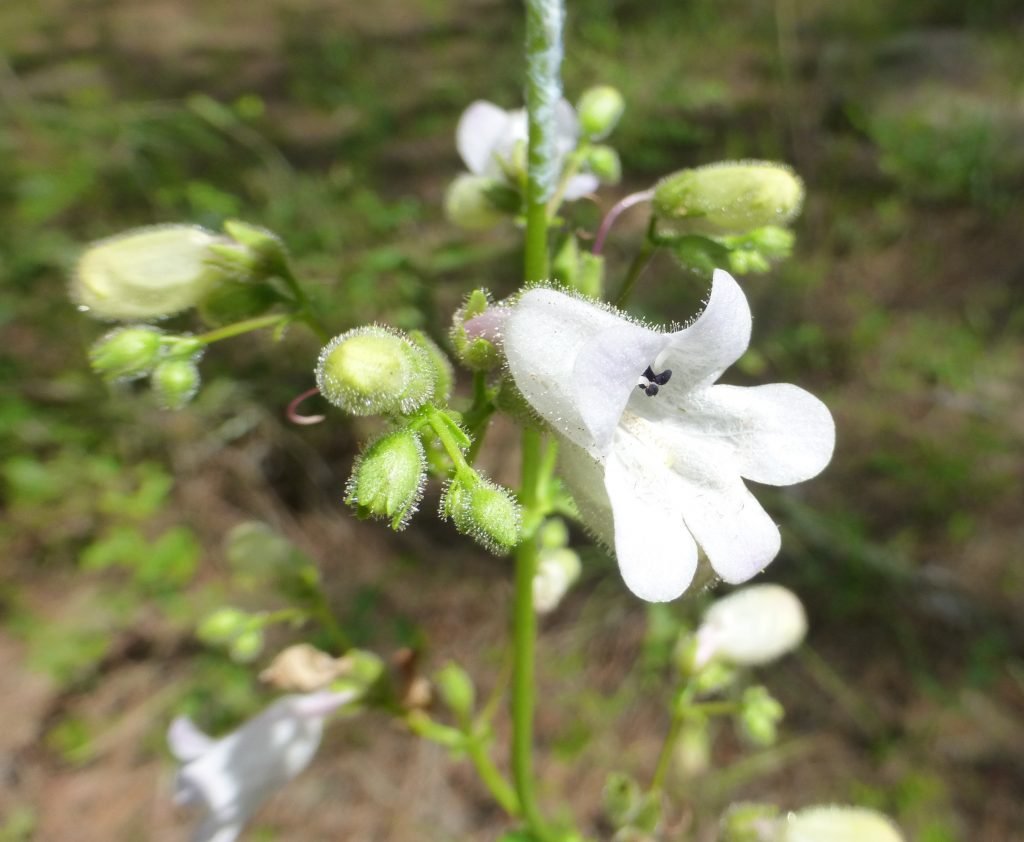
Many-flower beardtongue
( Penstemon multiflorus)
Common Name: Many-flower Beardtongue
Latin Name: Penstemon multiflorus
Family: Plantaginaceae (Plantain Family)
Form: A perennial wildflower that grows to a height of 2 feet tall when flowering.
Leaves: Penstemon has very few upper leaves with the majority of the leaves growing in a rosette at the base of the plant. When stem leaves are present they are opposite, sessile, oblanceolate in shape, with entire margins.
Flowers: White flowers appear in the spring and summer.
Habitat: Sandhills, dry pinelands, and scrub.
Native range: The entire State of Florida, and a few counties in southern Alabama, and southern Georgia.
Landscape use: In the home landscape penstemon is best planted in sparse areas where grass will not compete with these plants because they are slight wildflowers and will be overtaken with aggressive grass. It grows in part shade with dry soil.
Wildlife use: The flowers are a source of nectar for bumblebees and hummingbirds, and the dried seeds are eaten by some songbirds.
Propagation: Best achieved by seed. However seed requires 60 – 90 days of cold stratification in order to break dormancy. Attempting to transplant usually causes the plant to die.
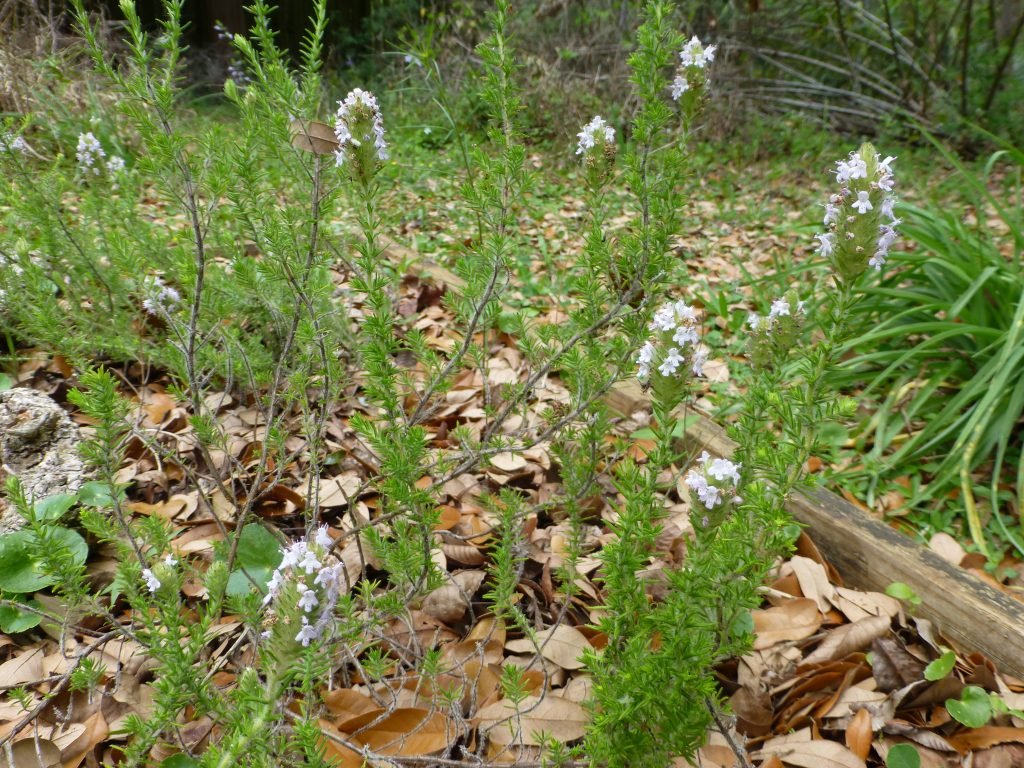
Pennyroyal
( Piloblephis rigida)
Common Name: Pennyroyal
Latin Name: Piloblephis rigida
Family: Lamiaceae (Mint Family)
Form: A somewhat woody mint that grows to a mature size of about 3 feet in height and 3 feet wide.
Leaves: Opposite, numerous, thick, entire, needlelike & evergreen
Flowers: Pale purple flowers appear in the fall & winter.
Habitat: Pinelands and dry areas.
Native range: Native to Florida and Georgia.
Landscape use: Grows in full sun to part shade with average moisture.
Wildlife use: Butterflies and bees use the flowers as a nectar source.
Propagation: Can be grown from seed, however it takes 90 days of cold stratification before germination occurs. They do not transplant well because they shock easily.
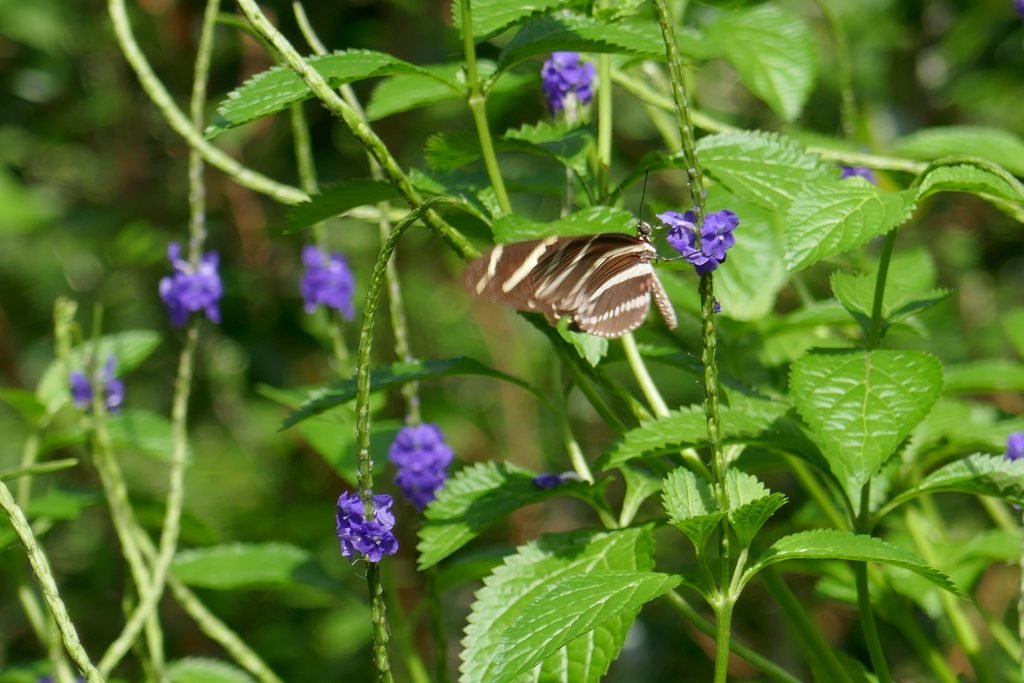
Porterweed
( Stachytarpheta jamaicensis)
Common Name: Blue Porterweed
Latin Name: Stachytarpheta jamaicensis
Family: Verbenaceae family (Vervaine Family)
Form: A perennial wildflower that will reach a size of about 1 ft tall and 3 ft wide.
Leaves: Opposite, toothed, ovate, & lanceolate to elliptic.
Flowers: Blue-violet flowers appear all year.
Habitat: Disturbed sites and coastal dunes.
Native range: Non-native. It is easily found at nurseries, grows very well, and the bumblebees love it.
Landscape use: Grows in full sun with average moisture.
Wildlife use: Butterflies use the flowers as a nectar source.
Propagation: It can be grown from seed, transplanted, or started from cuttings.
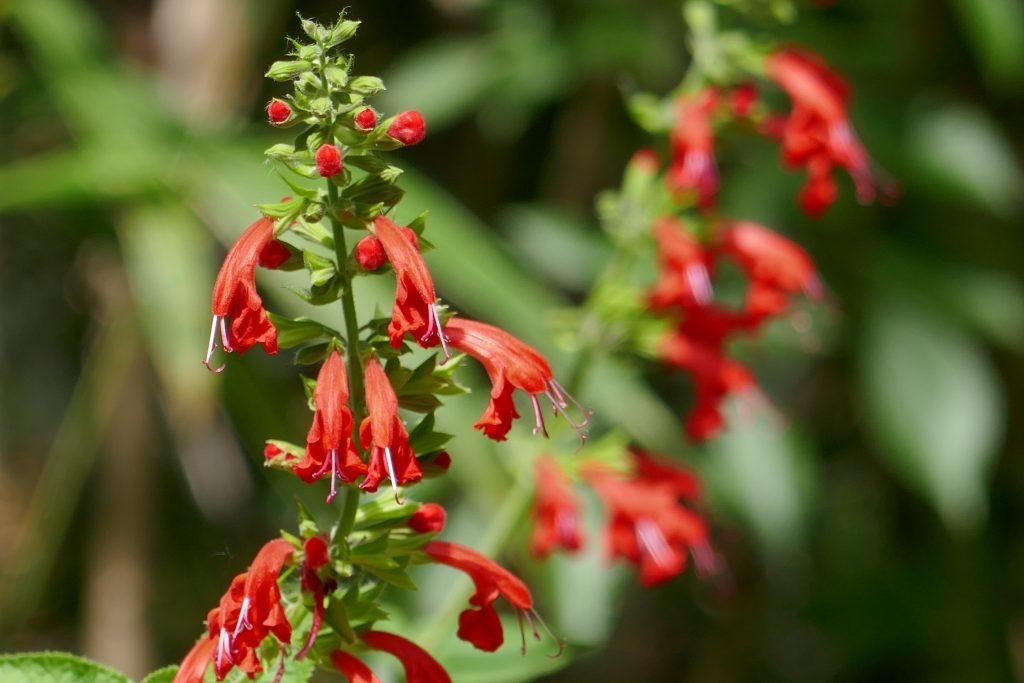
Red Salvia
(Salvia coccinea)
Common Names: Red Salvia
Latin Name: Salvia coccinea
Family: Lamiaceae family (Mint Family)
Form: A perennial wildflower which can reach a height of 2-3 feet in height.
Leaves: Opposite, stalked, and ovate with toothed margins.
Flowers: Red flowers that appear all year.
Habitat: Disturbed sites and thickets.
Native Range: Native to the entire Unites States.
Landscape use: In the home landscape it grows in full sun to part shade with average to moist soil. It readily re-seeds itself wherever it is planted.
Wildlife use: Butterflies, hummingbirds, and bees use the flowers as a source of nectar. Generally bees prefer blue and purple flowers, however they use these heavily if it is all that is available.
Propagation: Easily transplanted and grown from seed.
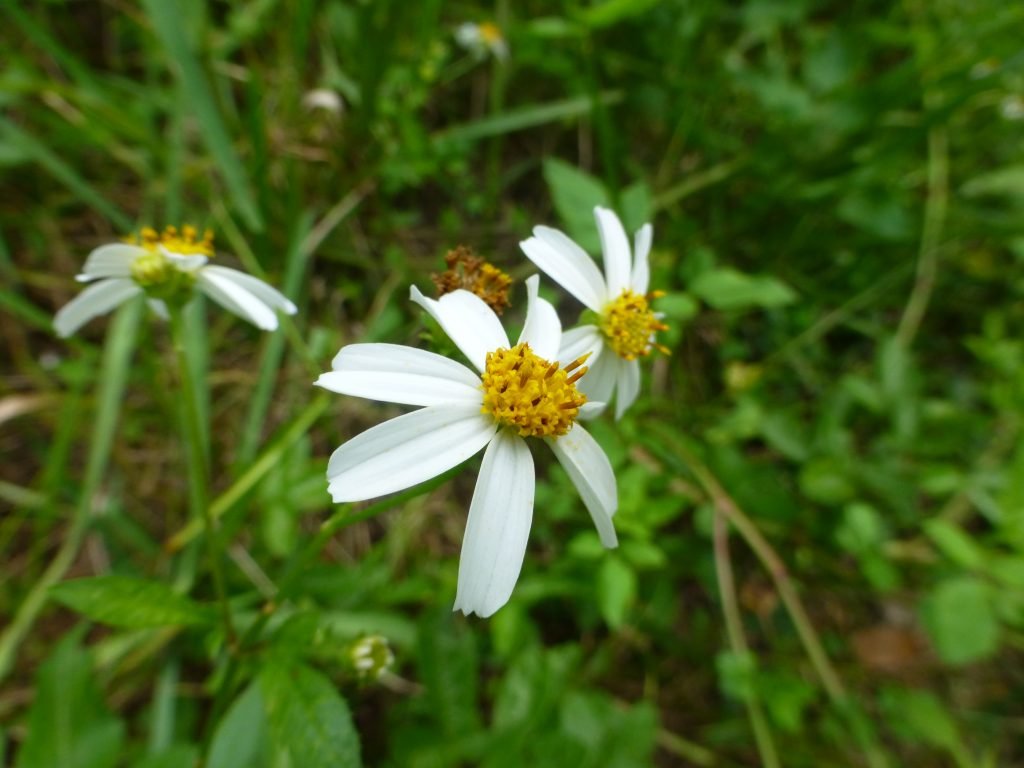
Spanish Needles
(Bidens alba)
Common Names: Red Salvia
Latin Name: Salvia coccinea
Family: Lamiaceae family (Mint Family)
Form: A perennial wildflower which can reach a height of 2-3 feet in height.
Leaves: Opposite, stalked, and ovate with toothed margins.
Flowers: Red flowers that appear all year.
Habitat: Disturbed sites and thickets.
Native Range: Native to the entire Unites States.
Landscape use: In the home landscape it grows in full sun to part shade with average to moist soil. It readily re-seeds itself wherever it is planted.
Wildlife use: Butterflies, hummingbirds, and bees use the flowers as a source of nectar. Generally bees prefer blue and purple flowers, however they use these heavily if it is all that is available.
Propagation: Easily transplanted and grown from seed.
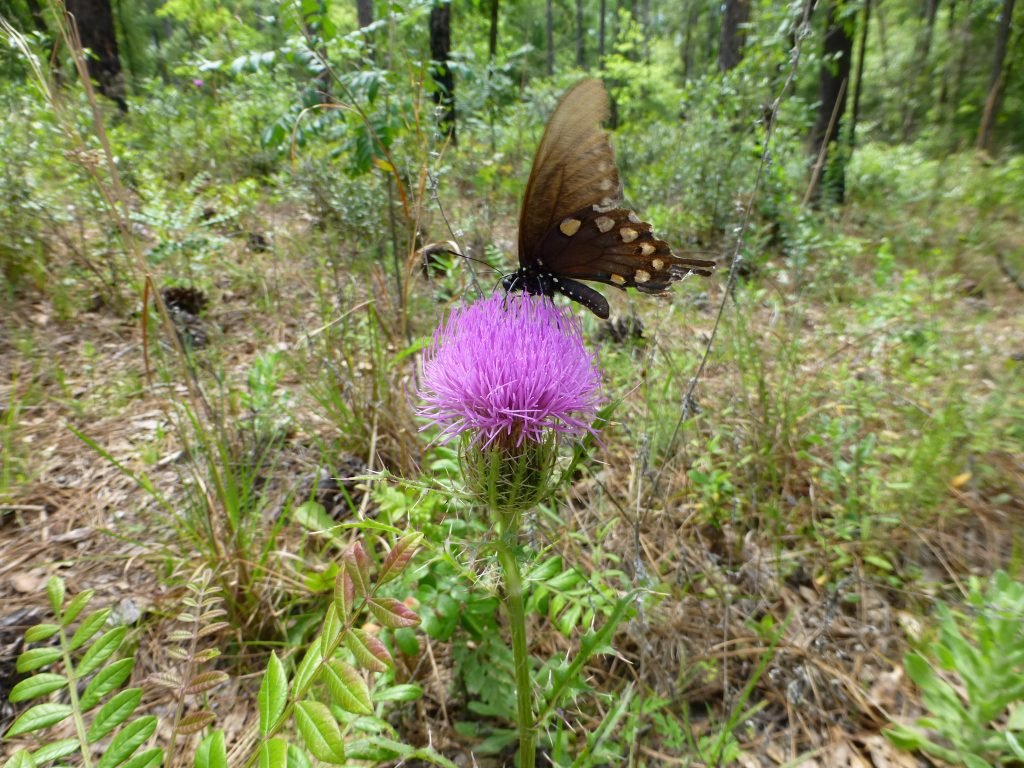
Thistle
(Cirsium horridulum )
Common Names: Purple Thistle
Latin Name: Cirsium horridulum
Family: Asteraceae (Aster Family)
Form: A perennial widlfower that can reach a height of four feet when in bloom.
Leaves: Alternate, spiny and deeply lobes with the base of the leaves wrapping around the stem downward.
Flowers: The large purple flowers appear in the spring and summer.
Habitat: Pinelands, old fields, pastures and disturbed sites
Native Range: Native to the following states: AL, AR, CT, DE, FL, GA, LA, MA, MD, ME, MS, NC, NH, NJ, NV, NY, OK, PA, RI, SC, TN, TX, and VA.
Landscape use: It grows in full sun to part shade with average moisture. If you allow any plants coming up in your green space to stay where they are it will be the perfect spot for them to thrive.
Wildlife use: Bumblebees and butterflies use the flowers as a nectar source.
Propagation: They transplant well and can also be grown from seed.
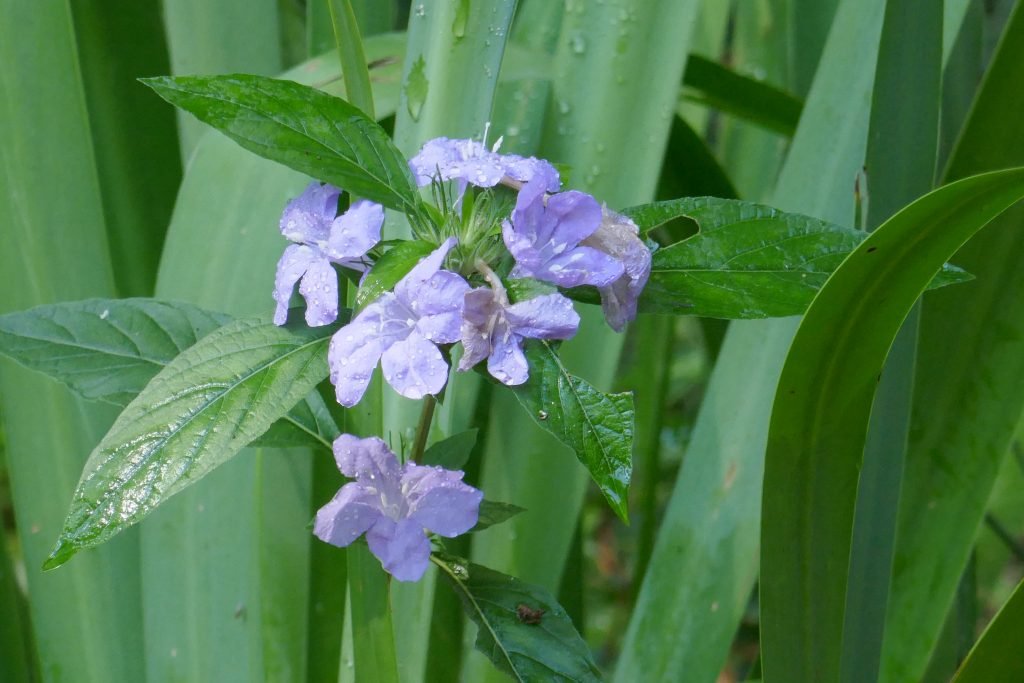
Wild Petunia
(Ruellia caroliniensis)
Common Names: Wild Petunia
Latin Name: Ruellia caroliniensis
Family: Acanthaceae (Acanthus Family)
Form: A perennial wildflower that grows to about 2 feet in height.
Leaves: Opposite, ovate to elliptic in shape, stalked, with entire margins.
Flowers: The pale lavender, large petaled, blooms appear in the spring, summer and fall and are a favorite of butterflies and bees.
Habitat: Dry, open, forests, sandhills, flatwoods, and clearings.
Native Range: AL, AR, DC, DE, FL, GA, IL, IN, KY, LA, MD, MS, NC, NJ, OH, OK, PA, SC, TN, TX, VA, and WV.
Landscape use: It grows in full sun to part shade with average moisture.
Wildlife use: Bumblebees and butterflies use the flowers as a nectar source.
Propagation: They transplant well and can also be grown from seed.
You might also like Little Known Pollinators